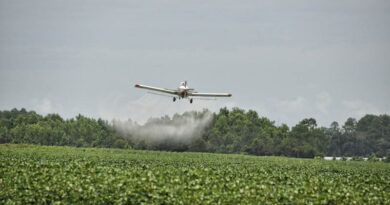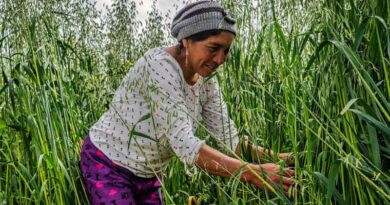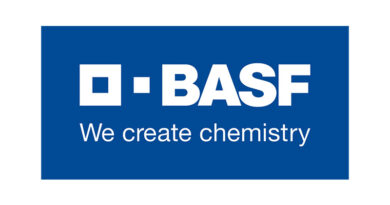Intercropping: ecological, economic food production at its modern best
17 April 2023, UK: By Dr. Alison Karley a research leader in Agroecology at the James Hutton Institute. This article first appeared in The Herald on 13 April 2023
Allotments conjure up a mix of images in people’s minds – quiet havens for getting away from domestic noise or pressures; mini family food factories; or even prize-winning vegetable nurseries.
From the air, allotments must look like mini patchworks of farmland, of no-fixed design.
In stark contrast, of course, to how sprawling fields across Scotland are starting to look from this time of year onwards, with their orderly rows of identical produce, impeccably planted, all set to uniformly sway in the spring breeze.
But this apparent cultural and functional divide between small-scale cultivated patchworks and large-scale industrial order isn’t as wide commercially or scientifically as you might think.
Field trials currently being led by The James Hutton Institute (the Hutton) have been looking closely at how cultivating often-very different crops together, side-by-side in the same field at the same time, can actually make agricultural production more resilient and environmentally sustainable.
The farming term for the practice is ‘intercropping’, and at these times of economic strife this ‘growing happily together’ concept is gaining traction, and the science and methodology behind it is being examined in more detail than ever.
Intercropping is a hot topic within our own fields and labs in Invergowrie, where we have a particular focus on how we can better cultivate legumes – plants that produce seeds in pods, such as beans, peas, and lentils.
Along with our own world-leading scientists, we work with other top crop scientists, breeders, food producers, crofters and farmers, from Scotland and around the world, who have already demonstrated the potential for multiple positive impacts of intercropping, to see how the process can be scientifically improved.
The work has shown, for instance, it can help improve soil fertility, use less water, reduce weed growt, and allow a more diverse range of quality food to be grown locally all year-round. In turn, this reduces the need for imports, thus cutting transport costs, with or without the effects of economic shocks.
The work on soil health is especially exciting, as intercropping has been shown to allow more and different types of nutrients to be left in the ground to help the following season’s crop, as well as reducing the need for artificial fertilisers. Even better is the fact that intercropping increases the diversity of the crop and, as a result, the diversity of organisms the crop supports. This includes beneficial organisms such as pollinators and natural enemies of crop pests, which can reduce the need for pesticides.
Successful intercropping can take many forms – from simply sowing several crops simultaneously next to each other, to including ‘companion crops’ that help protect a main cash crop from damage by weather, weeds, pests, or diseases. It can also involve growing carefully chosen ‘cover crops’ over winter to improve soil structure and protect against soil erosion.
An example of a perennial-annual intercropping match in this country is when cereals are grown in between orchard plantations, known as silvo-arable cropping. In tropical regions, coffee or coconut and bananas make a popular perennial combination.
But crop pairing to enable two or more crops to flourish side by side and yield a better crop than when grown alone is not revolutionary. Intercropping was common in Scotland in past decades, the most traditional with oats and pea or beans grown together – an early intercrop known as a ‘mashlum’.
This wet-sounding combination was said to provide better stability of yield in bad years, and have a higher protein content than oats alone, and was first reported here as far back as the 1440s.
What is most-certainly 2023, however, is some of the science now being used daily in the painstaking intercropping trials being carried out to understand why some pairings work better than others.
The preference for single cropping year after year on the same land – intensive farming with the sole purpose of maximising yields – is largely blamed as lying at the very heart of many of the environmental problems associated with modern agriculture. Concerns over food security are adding huge pressure on Governments to look for alternative solutions.
Mix in a serious shortage of critical fertilisers – such as phosphorous and potassium – and how synthetic nitrogen fertiliser production is considered hugely energy-intensive and a major contributor to GHG emissions, and how a war in Europe is spiking energy prices and leaving global food supply chains at breaking point, we now have a multi-directional perfect storm in the agricultural sector that has intensified the need for agroecologists and farmers to work together to develop and trial urgent solutions.
Two key international research projects we were involved in are called ‘TRUE’ (Transition Paths to Sustainable Legume-based Systems in Europe) and DIVERSify (Designing InnoVative plant teams for Ecosystem Resilience and agricultural Sustainability).
These sister projects looked at ways of increasing legume growing in Europe, including intercropping. This can greatly increase farm biodiversity and create a more diverse landscape for animals, as well as more diverse food crops. A unique attribute of legumes is their ability to act as natural fertilisers, absorbing nitrogen from the air and adding it to soil in a usable form through their roots. Good for farmers and for the environment, natural fertilisers can reduce the need for synthetic ones.
Working with farmers in Scotland, the Hutton is also blazing a trail in demonstrating how intercropping with legumes can create new and diverse sources of income. We helped the Stirling family – fourth generation farmers in Arbikie in Angus – create the world’s first carbon-neutral, climate-positive gin, Nadar. The clear spirit – now served in London’s Savoy hotel and other top hotels and bars around the world – is made from peas, and includes juniper, lemongrass and citrus leaf botanicals, all grown together on their own farm. Less glamorous, but equally important, the leftover pea residue is used as animal feed.
The latest market update from Kantar offered little comfort to anyone’s wallets or purses.
UK grocery price inflation hit a record 17.5% in the four weeks to March 1st, with average households now facing a potential £837 hike in the annual cost of their regular shopping basket. The Hutton’s overarching mission is to be international leaders in science on land, crops, natural resources and the wider natural environment. Their work aims to make sure that we can all not only afford to feed ourselves and eat better, but ensure food and drink production remains ultimately more secure and sustainable, on our own shores and those right around the planet.
Also Read: Tractor sale in India crosses 8 lakh mark
(For Latest Agriculture News & Updates, follow Krishak Jagat on Google News)















